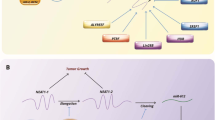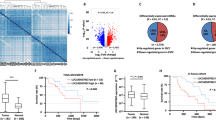Abstract
Small nucleolar RNA host gene 16 (SNHG16) is reported to be involved in the tumorigenesis of various kinds of tumors. SNHG16 expression was reported to be upregulated in colon cancer, however, the underlying mechanism of how SNHG16 affects the colon cancer development remains poorly elucidated. In our study, with the aim to identify the role of SNHG16 on colon cell proliferation, SNHG16 was overexpressed or knocked down in vitro, respectively. SNHG16 overexpression accelerated colon cancer cell growth, while cell growth ability was impaired in SNHG16 silencing cells. Furthermore, the starBase database predicted that miR-302a-3p was the target gene of SNHG16, which was supported by dual luciferase assay. The effect of promoting cell proliferation ability induced by SNHG16 overexpression could be partly reversed by co-transfection of miR-302a-3p mimic. Application of the miRanda database indicated that AKT may be modulated by SNHG16, further evidenced by western blot and quantitative PCR assays. AKT overexpression could partly reverse the attenuated colon cancer cell growth caused by miR-302a-3p mimic transfection. Meanwhile, the combination of miR-302a-3p inhibitor and shAKT achieved the parallel result. In conclusion, our study revealed the SNHG16/miR-302a-3p/AKT axis might play a crucial role in colon cancer cell proliferation, thus participating in the process of colon cancer development.





Similar content being viewed by others
References
Global Burden of Disease Cancer C, Fitzmaurice C, Allen C, Barber RM, Barregard L, Bhutta ZA, Brenner H, Dicker DJ, Chimed-Orchir O, Dandona R, Dandona L, Fleming T, Forouzanfar MH, Hancock J, Hay RJ, Hunter-Merrill R, Huynh C, Hosgood HD, Johnson CO, Jonas JB, Khubchandani J, Kumar GA, Kutz M, Lan Q, Larson HJ, Liang X, Lim SS, Lopez AD, MacIntyre MF, Marczak L, Marquez N, Mokdad AH, Pinho C, Pourmalek F, Salomon JA, Sanabria JR, Sandar L, Sartorius B, Schwartz SM, Shackelford KA, Shibuya K, Stanaway J, Steiner C, Sun J, Takahashi K, Vollset SE, Vos T, Wagner JA, Wang H, Westerman R, Zeeb H, Zoeckler L, Abd-Allah F, Ahmed MB, Alabed S, Alam NK, Aldhahri SF, Alem G, Alemayohu MA, Ali R, Al-Raddadi R, Amare A, Amoako Y, Artaman A, Asayesh H, Atnafu N, Awasthi A, Saleem HB, Barac A, Bedi N, Bensenor I, Berhane A, Bernabé E, Betsu B, Binagwaho A, Boneya D, Campos-Nonato I, Castañeda-Orjuela C, Catalá-López F, Chiang P, Chibueze C, Chitheer A, Choi J-Y, Cowie B, Damtew S, das Neves J, Dey S, Dharmaratne S, Dhillon P, Ding E, Driscoll T, Ekwueme D, Endries AY, Farvid M, Farzadfar F, Fernandes J, Fischer F, G/Hiwot TT, Gebru A, Gopalani S, Hailu A, Horino M, Horita N, Husseini A, Huybrechts I, Inoue M, Islami F, Jakovljevic M, James S, Javanbakht M, Jee SH, Kasaeian A, Kedir MS, Khader YS, Khang Y-H, Kim D, Leigh J, Linn S, Lunevicius R, HMA ER, Malekzadeh R, Malta DC, Marcenes W, Markos D, Melaku YA, Meles KG, Mendoza W, Mengiste DT, Meretoja TJ, Miller TR, Mohammad KA, Mohammadi A, Mohammed S, Moradi-Lakeh M, Nagel G, Nand D, Le Nguyen Q, Nolte S, Ogbo FA, Oladimeji KE, Oren E, Pa M, Park E-K, Pereira DM, Plass D, Qorbani M, Radfar A, Rafay A, Rahman M, Rana SM, Søreide K, Satpathy M, Sawhney M, Sepanlou SG, Shaikh MA, She J, Shiue I, Shore HR, Shrime MG, So S, Soneji S, Stathopoulou V, Stroumpoulis K, Sufiyan MB, Sykes BL, Tabarés-Seisdedos R, Tadese F, Tedla BA, Tessema GA, Thakur JS, Tran BX, Ukwaja KN, Uzochukwu BSC, Vlassov VV, Weiderpass E, Wubshet Terefe M, Yebyo HG, Yimam HH, Yonemoto N, Younis MZ, Yu C, Zaidi Z, Zaki MES, Zenebe ZM, Murray CJL, Naghavi M (2017) Global, regional, and National Cancer Incidence, mortality, years of life lost, years lived with disability, and disability-adjusted life-years for 32 Cancer groups, 1990 to 2015: A systematic analysis for the global burden of disease study. JAMA Oncol 3(4):524–548. https://doi.org/10.1001/jamaoncol.2016.5688
Gellad ZF, Provenzale D (2010) Colorectal cancer: national and international perspective on the burden of disease and public health impact. Gastroenterology 138(6):2177–2190. https://doi.org/10.1053/j.gastro.2010.01.056
Hutter CM, Chang-Claude J, Slattery ML, Pflugeisen BM, Lin Y, Duggan D, Nan H, Lemire M, Rangrej J, Figueiredo JC, Jiao S, Harrison TA, Liu Y, Chen LS, Stelling DL, Warnick GS, Hoffmeister M, Kury S, Fuchs CS, Giovannucci E, Hazra A, Kraft P, Hunter DJ, Gallinger S, Zanke BW, Brenner H, Frank B, Ma J, Ulrich CM, White E, Newcomb PA, Kooperberg C, LaCroix AZ, Prentice RL, Jackson RD, Schoen RE, Chanock SJ, Berndt SI, Hayes RB, Caan BJ, Potter JD, Hsu L, Bezieau S, Chan AT, Hudson TJ, Peters U (2012) Characterization of gene-environment interactions for colorectal cancer susceptibility loci. Cancer Res 72(8):2036–2044. https://doi.org/10.1158/0008-5472.CAN-11-4067
Jeon J, Du M, Schoen RE, Hoffmeister M, Newcomb PA, Berndt SI, Caan B, Campbell PT, Chan AT, Chang-Claude J, Giles GG, Gong J, Harrison TA, Huyghe JR, Jacobs EJ, Li L, Lin Y, Le Marchand L, Potter JD, Qu C, Bien SA, Zubair N, Macinnis RJ, Buchanan DD, Hopper JL, Cao Y, Nishihara R, Rennert G, Slattery ML, Thomas DC, Woods MO, Prentice RL, Gruber SB, Zheng Y, Brenner H, Hayes RB, White E, Peters U, Hsu L (2018) Determining risk of colorectal Cancer and starting age of screening based on lifestyle, environmental, and genetic factors. Gastroenterology 154(8):2152–2164.e2119. https://doi.org/10.1053/j.gastro.2018.02.021
Wapinski O, Chang HY (2011) Long noncoding RNAs and human disease. Trends Cell Biol 21(6):354–361. https://doi.org/10.1016/j.tcb.2011.04.001
Cabili MN, Trapnell C, Goff L, Koziol M, Tazon-Vega B, Regev A, Rinn JL (2011) Integrative annotation of human large intergenic noncoding RNAs reveals global properties and specific subclasses. Genes Dev 25(18):1915–1927. https://doi.org/10.1101/gad.17446611
Mattick JS, Rinn JL (2015) Discovery and annotation of long noncoding RNAs. Nat Struct Mol Biol 22:5. https://doi.org/10.1038/nsmb.2942
Schmitt AM, Chang HY (2016) Long noncoding RNAs in Cancer pathways. Cancer Cell 29(4):452–463. https://doi.org/10.1016/j.ccell.2016.03.010
Khaitan D, Dinger ME, Mazar J, Crawford J, Smith MA, Mattick JS, Perera RJ (2011) The melanoma-upregulated long noncoding RNA SPRY4-IT1 modulates apoptosis and invasion. Cancer Res 71(11):3852–3862. https://doi.org/10.1158/0008-5472.CAN-10-4460
Liu B, Sun L, Liu Q, Gong C, Yao Y, Lv X, Lin L, Yao H, Su F, Li D, Zeng M, Song E (2015) A cytoplasmic NF-κB interacting long noncoding RNA blocks IκB phosphorylation and suppresses breast Cancer metastasis. Cancer Cell 27(3):370–381. https://doi.org/10.1016/j.ccell.2015.02.004
Zhao W, Li W, Dai W, Huang N, Qiu J (2018) LINK-A promotes cell proliferation through the regulation of aerobic glycolysis in non-small-cell lung cancer. OncoTargets Ther 11:6071–6080. https://doi.org/10.2147/OTT.S171216
Ma M, Xu H, Liu G, Wu J, Li C, Wang X, Zhang S, Xu H, Ju S, Cheng W, Dai L, Wei Y, Tian Y, Fu X (2019) MITA1, a novel energy stress-inducible lncRNA, promotes hepatocellular carcinoma metastasis. Hepatology. https://doi.org/10.1002/hep.30602
Yu M, Ohira M, Li Y, Niizuma H, Oo ML, Zhu Y, Ozaki T, Isogai E, Nakamura Y, Koda T, Oba S, Yu B, Nakagawara A (2009) High expression of ncRAN, a novel non-coding RNA mapped to chromosome 17q25.1, is associated with poor prognosis in neuroblastoma. Int J Oncol 34(4):931–938. https://doi.org/10.3892/ijo_00000219
Zhu H, Zeng Y, Zhou C-C, Ye W (2018) SNHG16/miR-216-5p/ZEB1 signal pathway contributes to the tumorigenesis of cervical cancer cells. Arch Biochem Biophys 637:1–8. https://doi.org/10.1016/j.abb.2017.11.003
Lu YF, Cai XL, Li ZZ, Lv J, Xiang Y, Chen JJ, Chen WJ, Sun WY, Liu XM, Chen JB (2018) LncRNA SNHG16 functions as an oncogene by sponging MiR-4518 and up-regulating PRMT5 expression in glioma. Cell Physiol Biochem 45(5):1975–1985. https://doi.org/10.1159/000487974
Cao X, Xu J, Yue D (2018) LncRNA-SNHG16 predicts poor prognosis and promotes tumor proliferation through epigenetically silencing p21 in bladder cancer. Cancer Gene Ther 25(1):10–17. https://doi.org/10.1038/s41417-017-0006-x
Zhao W, Fu H, Zhang S, Sun S, Liu Y (2018) LncRNA SNHG16 drives proliferation, migration, and invasion of hemangioma endothelial cell through modulation of miR-520d-3p/STAT3 axis. Cancer Med 7(7):3311–3320. https://doi.org/10.1002/cam4.1562
Cai C, Huo Q, Wang X, Chen B, Yang Q (2017) SNHG16 contributes to breast cancer cell migration by competitively binding miR-98 with E2F5. Biochem Biophys Res Commun 485(2):272–278. https://doi.org/10.1016/j.bbrc.2017.02.094
Xu F, Zha G, Wu Y, Cai W, Ao J (2018) Overexpressing lncRNA SNHG16 inhibited HCC proliferation and chemoresistance by functionally sponging hsa-miR-93. OncoTargets Ther 11:8855–8863. https://doi.org/10.2147/OTT.S182005
Gibb EA, Warren RL, Wilson GW, Brown SD, Robertson GA, Morin GB, Holt RA (2015) Activation of an endogenous retrovirus-associated long non-coding RNA in human adenocarcinoma. Genome Med 7(1):22–22. https://doi.org/10.1186/s13073-015-0142-6
Christensen LL, True K, Hamilton MP, Nielsen MM, Damas ND, Damgaard CK, Ongen H, Dermitzakis E, Bramsen JB, Pedersen JS, Lund AH, Vang S, Stribolt K, Madsen MR, Laurberg S, McGuire SE, Ørntoft TF, Andersen CL (2016) SNHG16 is regulated by the Wnt pathway in colorectal cancer and affects genes involved in lipid metabolism. Mol Oncol 10(8):1266–1282. https://doi.org/10.1016/j.molonc.2016.06.003
Wang C, Yao B, Xu M, Zheng X (2016) RIP1 upregulation promoted tumor progression by activating AKT/Bcl-2/BAX signaling and predicted poor postsurgical prognosis in HCC. Tumor Biol 37(11):15305–15313. https://doi.org/10.1007/s13277-016-5342-1
C-c Z, Chen C, Z-q X, J-k Z, B-c O, Sun J, Zheng M-h, Y-p Z, A-g L (2018) CCR6 promotes tumor angiogenesis via the AKT/NF-κB/VEGF pathway in colorectal cancer. Biochim Biophys Acta (BBA) - Mol Basis Dis 1864(2):387–397. https://doi.org/10.1016/j.bbadis.2017.10.033
Shao J, Zhu W, Ding Y, Zhu H, Jing X, Yu H, Lu M, Qiao Y, Wang X, Ai H, Wang X (2019) Phosphorylation of LIFR promotes prostate cancer progression by activating the AKT pathway. Cancer Lett 451:110–121. https://doi.org/10.1016/j.canlet.2019.02.042
Ahmed D, Eide PW, Eilertsen IA, Danielsen SA, Eknæs M, Hektoen M, Lind GE, Lothe RA (2013) Epigenetic and genetic features of 24 colon cancer cell lines. Oncogenesis 2(9):e71
Jasperson KW, Tuohy TM, Neklason DW, Burt RW (2010) Hereditary and familial Colon Cancer. Gastroenterology 138(6):2044–2058. https://doi.org/10.1053/j.gastro.2010.01.054
Siegel RL, Miller KD, Fedewa SA, Ahnen DJ, Meester RGS, Barzi A, Jemal A (2017) Colorectal cancer statistics, 2017. CA Cancer J Clin 67(3):177–193. https://doi.org/10.3322/caac.21395
Song M, Bode AM, Dong Z, Lee M-H (2019) AKT as a therapeutic target for Cancer. Cancer Res 79(6):1019. https://doi.org/10.1158/0008-5472.CAN-18-2738
Li Y, Yang Q, Guan H, Shi B, Ji M, Hou P (2018) ZNF677 suppresses Akt phosphorylation and tumorigenesis in thyroid Cancer. Cancer Res 78(18):5216. https://doi.org/10.1158/0008-5472.CAN-18-0003
Acknowledgements
This research was Supported by Hubei Provincial Natural Science Foundation of China(2017CFB781).
Author information
Authors and Affiliations
Corresponding author
Ethics declarations
Conflict of Interest
There is no conflict of Interest.
Additional information
Publisher’s Note
Springer Nature remains neutral with regard to jurisdictional claims in published maps and institutional affiliations.
Rights and permissions
About this article
Cite this article
Ke, D., Wang, Q., Ke, S. et al. Long-Non Coding RNA SNHG16 Supports Colon Cancer Cell Growth by Modulating miR-302a-3p/AKT Axis. Pathol. Oncol. Res. 26, 1605–1613 (2020). https://doi.org/10.1007/s12253-019-00743-9
Received:
Accepted:
Published:
Issue Date:
DOI: https://doi.org/10.1007/s12253-019-00743-9




